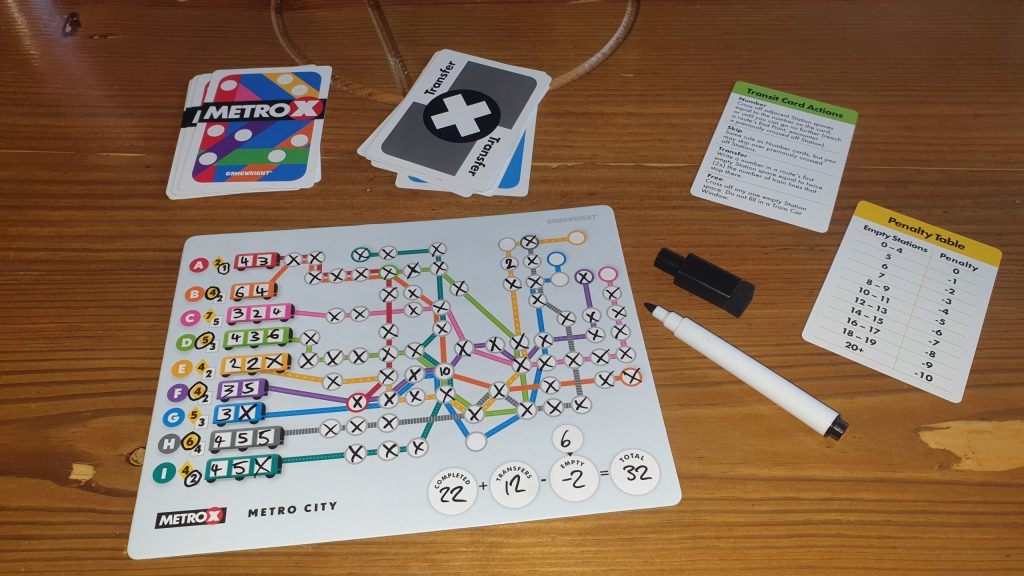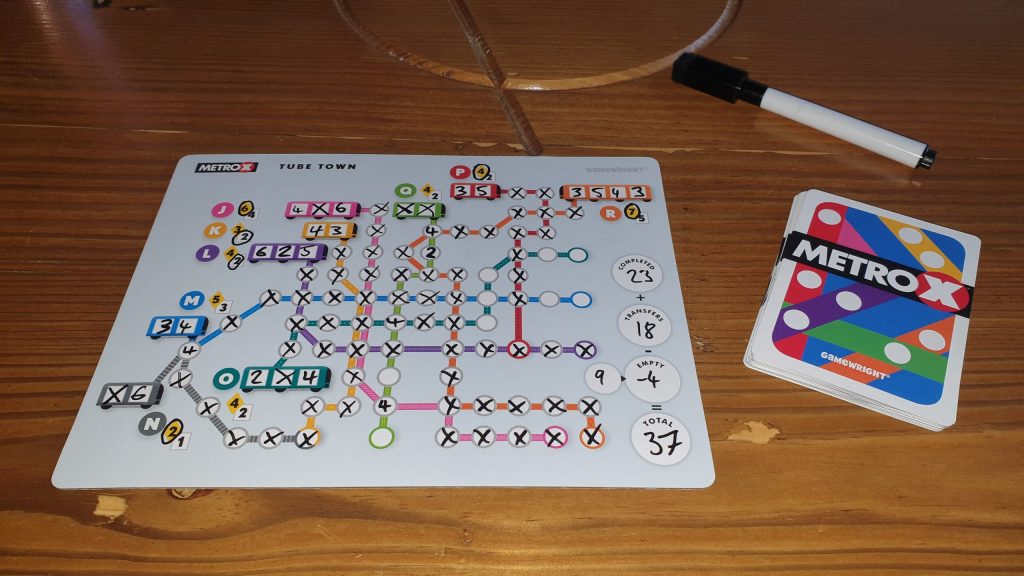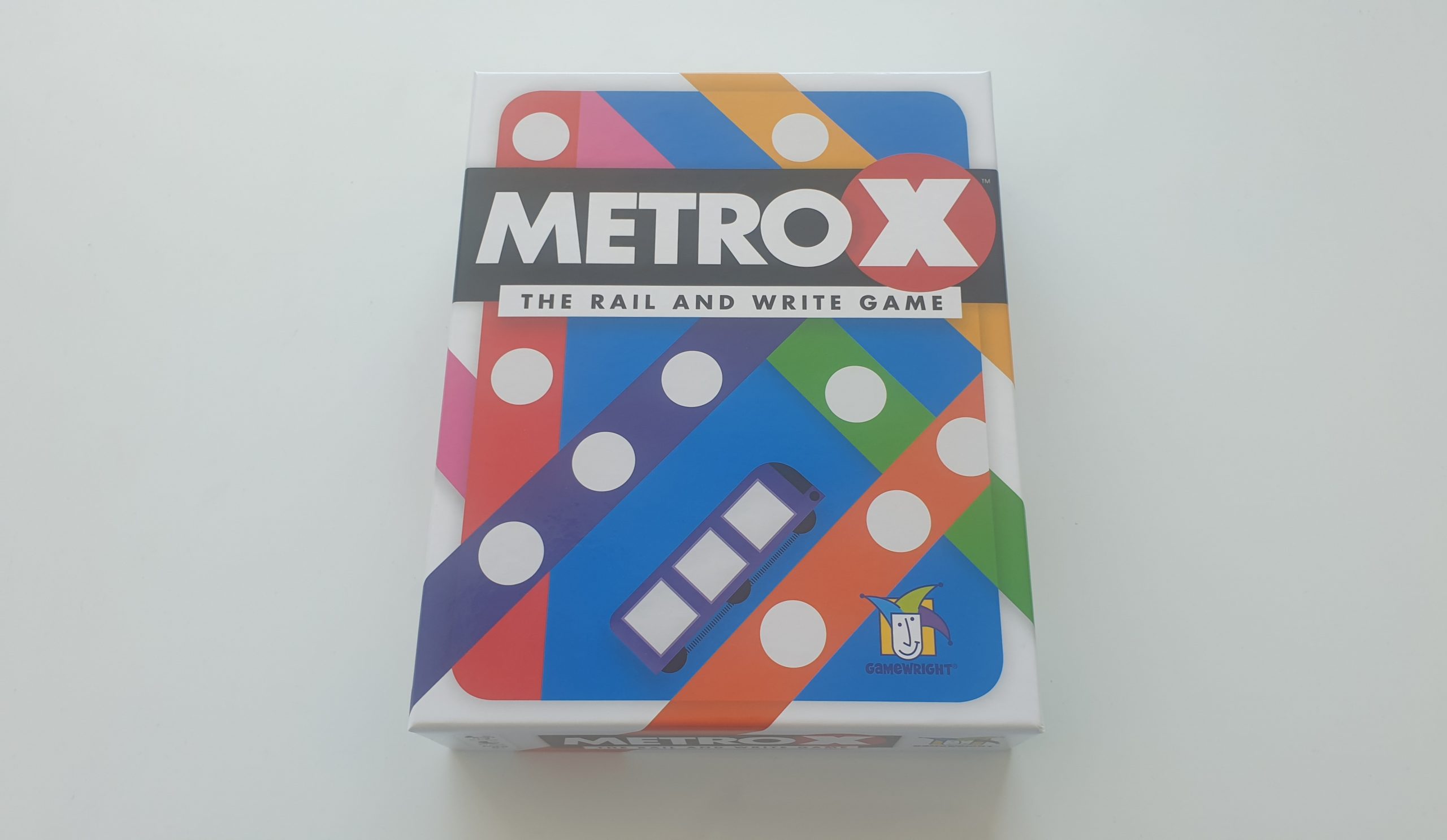Metro X is a flip and write board game, falling into the roll and write genre, from publisher Gamewright, which was originally released in Japanese. Designed to work with an unlimited number of players – there are enough components in the box for 1 – 6 players. Themed around subways, players will be filling in trains and stops, with the subways criss-crossing over each other. However, is this a fun way to spend 20 minutes? Let’s find out!
At the start of the game each player takes a board and pen from the box. Choosing either Tube Town or Metro City all players must use the same side of the board. Reminder cards, which have the actions and part of the end game scoring, are passed out – with the deck of 15 transit cards shuffled. Setup is that simple, with the game ready to go.
There are no individual player turns in Metro X. Each round a card is turned over and simultaneously all players use what is shown. One player can be nominated as the card flipper, otherwise all players perform the same action every round. There are 4 types of action that can come out of the deck: number, skip, transfer and free space.
The first two are very similar. Both number and skip see a numbered value come out of the deck. Each player then writes the number onto one of the empty train windows. Following that train route until the first empty stop is found, the player then puts an X mark into stops onward from the empty one, up to the number on the transit card. For “number” numbers this can be until either the end of the line or a previously crossed off stop is reached. Skip works slightly differently, as any previously filled in stop can be skipped over, though still ending if the end of the line is reached.

When a transfer card is revealed players choose an empty train window to put an X mark in. Again following the subway route until the first empty stop is located a number is written onto the stop. The number, which is double the number of routes that pass through the stop, is scored as bonus points at the end of the game. The final, rarest, action is free space. This simply allows players to put an X mark into any of their empty stops, requiring nothing to be added to a train car window.
Once all players have used the action, a new card is flipped from the deck for the next round and so on. One of the transit cards is a number 6 and when this comes up all transit cards are reshuffled, so the deck can never run out. Whenever a player finishes a subway line completely they circle a bonus associated with it. If they are the first to have finished it then they gain a golden, higher scoring bonus, with all others that complete it later on getting a lower completion bonus.
Over the course of the game all 23 train windows will be filled, with all players simultaneously finishing. Often there are slightly more than 23 rounds, due to free space. When finished players sum their points earnt for completing subway lines and the bonus points from transfers. Using the table on the reference card, players then determine how many points they have lost from leaving empty stops on their board. After this, whomever has the most points wins, with ties split by the fewest empty stops.
Having two maps straight out of the box is a brilliant way of stopping the game from feeling samey. Other games of the roll and write genre depend only on the order of what comes up changing. In Metro X players merely need to flip the board for a new puzzle to present itself. The rulebook suggests starting on the Metro City side – which may be slightly simpler. Though, I have found that despite the more criss-crossing nature of the Tube Town board, its grid structure makes it easier to follow.

For a deck of only 15 cards, the transit deck gives players both hope and an intriguing puzzle. The majority of the cards are just numbers, so players will have to debate using them fully on one line or being only able to partially use them on another. Players always have hope that a skip or free space will come up to plug gaps in their subway network. Transfers are able to provide a lot of points but often these come at the expense of being unable to finish a subway line. Each turn is a balancing act of what is most likely going to come up and what will be easiest to finish, for the most points.
At least to some extent Metro X should be colour blind friendly. While a lot of similar colours are utilized, each subway route features a different pattern, helping them be distinguishable. As mentioned, the Metro City side is slightly harder to follow where routes are going at a glance. Still, the graphical design does allow for it to be obvious where subways cross. Also, via use of colour, it easily denotes which stops are the end of specific lines. Driven by way the tracks cross over each other and stop at the same subway stations, there is a thematic look to the subway maps – even if they aren’t dripping with gorgeous artwork.
One roll and write bugbear is pads of paper for the scoresheets. Metro X avoids this with wipeable, sturdy, cardboard boards – giving the game a more premium, less disposable feel. The drywipe pens coming with eraser ends may not sound like a huge deal. Yet, they make playing more pleasant. On top of not having to use a spare cloth or your finger to rub the pen off the board – it helps the game stay clean for a little longer. As with any drywipe boards the white colour starts to grey with use. They just need a proper clean and the erasers help make the frequency of proper cleans that little lower. In one way the box feels too big for the components of Metro X. However, the box is that size to allow the player boards to be a decent size. If they were smaller they’d only become awkward to fill in legibly.
Often a roll or flip and write is different game to game because of what comes up or the order, being overly reliant on the one puzzle. Metro X comes with two out of the box and it only makes me want more. Regardless of if an expansion is released though, Metro X has the table staying power of a longer game. It can be used as a filler of time with 20 minutes for one game, or players can flip the board over and play a second game to have had an enjoyable 40 minutes. Many roll and writes don’t compel players to instantly play again, just play again at another time. It was certainly a clever move by Gamewright to have two maps and it is a clever puzzle to crack, which is why Metro X has earnt its space on my gaming shelf!
(Editor’s Note: Metro X was provided to use by Coiledspring Games for the review. Check out it’s official store page here.)

